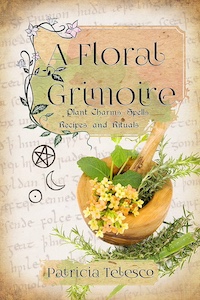
A Floral Grimoire: Plant Charms, Spells, Recipes and Rituals, by Patricia Telesco
Crossed Crow Books, 9781959883739, 187 pages, March 2024
When I saw A Floral Grimoire: Plant Charms, Spells, Recipes, and Rituals, I was drawn to learning about the ways to use flowers and herbs in my daily, magical life. In this book Patricia, “Trish”, Telesco weaves a beautiful chronicle of history, lore, practical steps, and magical vibes. I learned about flowers, as well as how to use the rest of the plant for potions, crafts, and much more.
Calling herself a “kitchen witch,” Telesco studied Wicca on her own and then became initiated by the Stega tradition of Italy. As the author of over 30 books, she also coordinates spiritually oriented tours of Europe. She shares her knowledge of herbs, metaphysics, dreams, divination, folklore and magic in workshops and lectures around the US. She lives in western upstate New York with her husband and children. You can learn more about Telesco on her website.
Telesco begins with a history of the use of flowers, mentioning the Victorians and their creation of a “petaled vocabulary”1 for secret messages. Then she goes on to share how merchants during the Crusades “often mingled magical lore and wives’ tales into their selling techniques.”2 She provides two examples that we still see today in our modern world: sprinkling rose petals for love and using garlic to keep away “wandering spirits.”3 From here, she invites the reader to become involved in “Green Witchery” and travel with her through this practical guidebook for discovering more about nature and magic.
The book is an easy read, almost as if you are sitting with Telesco for a cup of tea and about to make a craft with flowers and herbs. She shares more history and folklore from botany, herbology, and the magical arts, as she includes her knowledge and wisdom from more than 30 years of experience as a Green Witch too.
Telesco’s stories of the various uses for flowers, plants, and other natural elements includes the Greek myth of Hekate teaching her daughters all about herbs. The tradition says that these daughters taught other witches how to utilize this magic. She goes on to say that “this myth, which is one of many linking Witches and nature together, gives us a peek into the minds of our ancestors.”4
My favorite chapter was ”Chapter 6: Petaled Psychism: Floromancy and Botanomancy”. In other words, how to use flowers, herbs, stone, or wood for divination. In this chapter, she includes how to observe the plants and flowers that grow around us, as well as casting herbs or flowers on water or cloth to receive a message. She also shares how to make a flower or herb pendulum and an oracle to keep for use over time. I want to try my hand at making a pressed flower oracle later this spring!
In this chapter, she also includes spreads for use with your oracle cards, as well as guidelines for doing readings. In fact, all throughout the book Telesco includes guidelines to help the novice better utilize the knowledge and rituals she shares.
And what book on flowers and herbs for magic would be complete without information on edible flowers? Telesco includes recipes for all kinds of teas, beverages, oils, vinegars, and sauces, as well as a recipe for Mystic Mushrooms5 and Peace Porridge6.
An interesting list that the author includes in the book is a “List of Anti-Magic and Anti-Witch Herbs.”7 This list contains things from nature that can protect the witch in adverse circumstances. Later, she adds a list of herbs, flowers and plants that can honor and support witches and their magic.
Some other lists and information I found helpful:
“Ways to use a leaf you find on your walk”8
“How to get in touch with a plant spirit”9
“How to use the Moon by Zodiac sign”10
“Tools of the Trade”11
“Ingredients for Spells & Charms”12
That last list, in a chapter titled “Spicy Spells & Charms”, includes how to use anything from alfalfa to violets for “pleasing and powerful results.”13 And I must point out that these are just a few of the lists that are sprinkled throughout the book!
Another key bit of knowledge Telesco includes is called the Doctrine of Signatures and Law of Similars. If you do not have a particular flower or plant for a spell or ritual, “you can substitute an item of a similar shape, texture or color and still maintain magical congruency.”14 For example, a pale blue flower could be substituted for lavender.
This book has a wonderful Table of Contents that shares chapter titles and brief subheadings for the contents of each chapter. This makes it very easy to find passages or information later. Telesco also includes an eleven-page index, which makes retrieving information even easier! She also shares an extensive bibliography for future research.
A Floral Grimoire is great for a new witch or seasoned pro. It holds valuable information for anyone wanting to harness the power of nature in their daily life. I will refer often to the information for spells and charms, as well as the ingredients list and correspondence list. With the various lists and the index, I have a valuable reference for utilizing flowers and herbs in practical and magical ways. I can see myself adding this book to the resource list I provide clients who come to me for readings for their daily lives.

PJ Spur is an author, intuitive, spiritual mentor, astrologer, and hypnotist. She does tarot & oracle card readings, natal chart readings, grief coaching, and relationship healing. She also has hosted a weekly “Coffee & Cards” event with her Soul Compass Community for the past four years. Her book Navigating Grief with Grace is available on Amazon. Learn more at www.dearpj.com
